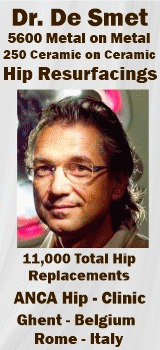Many thanks to the three of you for your quick responses. This is the first I have heard of this theory, and if true, it at least makes intuitive sense so thank you for the explanation. I'll dig into it some more.
I wanted to keep the first post to the point, but now I'll give some background. I'm 33 years old. I was an active mountaineer and runner through most of the 2000s but developed severe chronic deep aching in both of my hips (right-side much worse) in late 2008 and was diagnosed with FAI (cam) -caused osteoarthritis.
I ended up having bilateral hip arthroscopies with Dr Sampson in SF mid-2009. The left hip was relatively straightforward (femoral neck resection to "fix" the cam FAI and labral repair). There was only minor articular cartilage damage and it's holding up reasonably well to this day (it's not a perfect hip, but I only have occasional and minor complaints about it). The right hip was much more severely damaged. There was a medium-sized area of articular cartilage which had delaminated, so that was removed and I got microfracture (in addition to resolving the underlying FAI). Other areas of articular cartilage had thinned at that point also.
The right hip also actually did very well until about 18 months ago (it was a *drastic* improvement from pre-surgery and I returned to full activity). About 18 months ago, what I call "museum sightseeing" started to end in a very acute stabbing pain deep inside my hip. While walking I would get intense sharp, but unpredictable pains from inside my right hip. Strangely, at this point I didn't get any chronic ache afterward. Fast-forward to the last 3-6 months and now the same thing happens far more frequently. I cannot hike more than a mile or so anymore without provoking this, and I do get a moderate-level chronic ache again, just like I did before the arthroscopy. The chronic ache comes and goes, but I am very concerned about the rapid deterioration in my condition.
I understand that the consensus is that regular repeat microfracture isn't really a workable solution, so I have been investigating a hip resurfacing as I wish to remain very active and I need the implant to last as long as absolutely possible given my age. To be fair, I am still relatively active (I do crossfit a few days a week, for example, and I scuba dive very regularly). However, I cannot hike, traveling is very difficult (as it tends to provoke the stabbing pains that cause me to almost collapse), and I am guessing that somewhere in the next couple of years I am going to have to further modify my activity to maintain my sanity.
Dr Schmalzried said that I was a clear candidate for hip resurfacing, but that he recommended trialling cortisone injections to see if I can buy more time. He didn't mention anything about blood supply, but just said that he was concerned about the implant lifetime and given my age recommended delaying. He was very clear though that he thought that fitness and strength level at the time of surgery was important, and he thought that I should have the surgery before I had to modify my activity-level further. One interesting point is that Dr Schmalzried hypothesized that the sharp acute pain could be cartilage on the edge of the microfracture area delaminating and getting caught on the femoral head.
Dr Bose is also suggesting waiting and trying to get by with steroid injections, but for a different stated reason.
I have not yet tried a cortisone injection, as I was concerned that it may cause more damage to the area. Obviously if the cartilage is damaged at this point, that is what it is and would be removed in the surgery regardless. I'm more concerned about weakening / damage to the bone and I know at least some of the surgeons (Dr Pritchett?) recommend against cortisone injections for this reason.
So, I am waiting for a call from Dr Gross to get his impressions, as well as an email from Dr De Smet. If they do not strongly recommend against it, I will go ahead and get a cortisone injection and see how long that buys me. I will also get their thoughts on the risk I am taking
Finally, I am also following up with Dr Sampson (and he has requested MRIs, so I will get a somewhat more detailed idea of the state of the cartilage).
Is there any way to evaluate the blood supply within the bone (vs outside) with an imaging technique?
Again, thanks to all. This is certainly a roller-coaster!
EDIT: Removed an incorrect "no longer" in one of the sentences.











